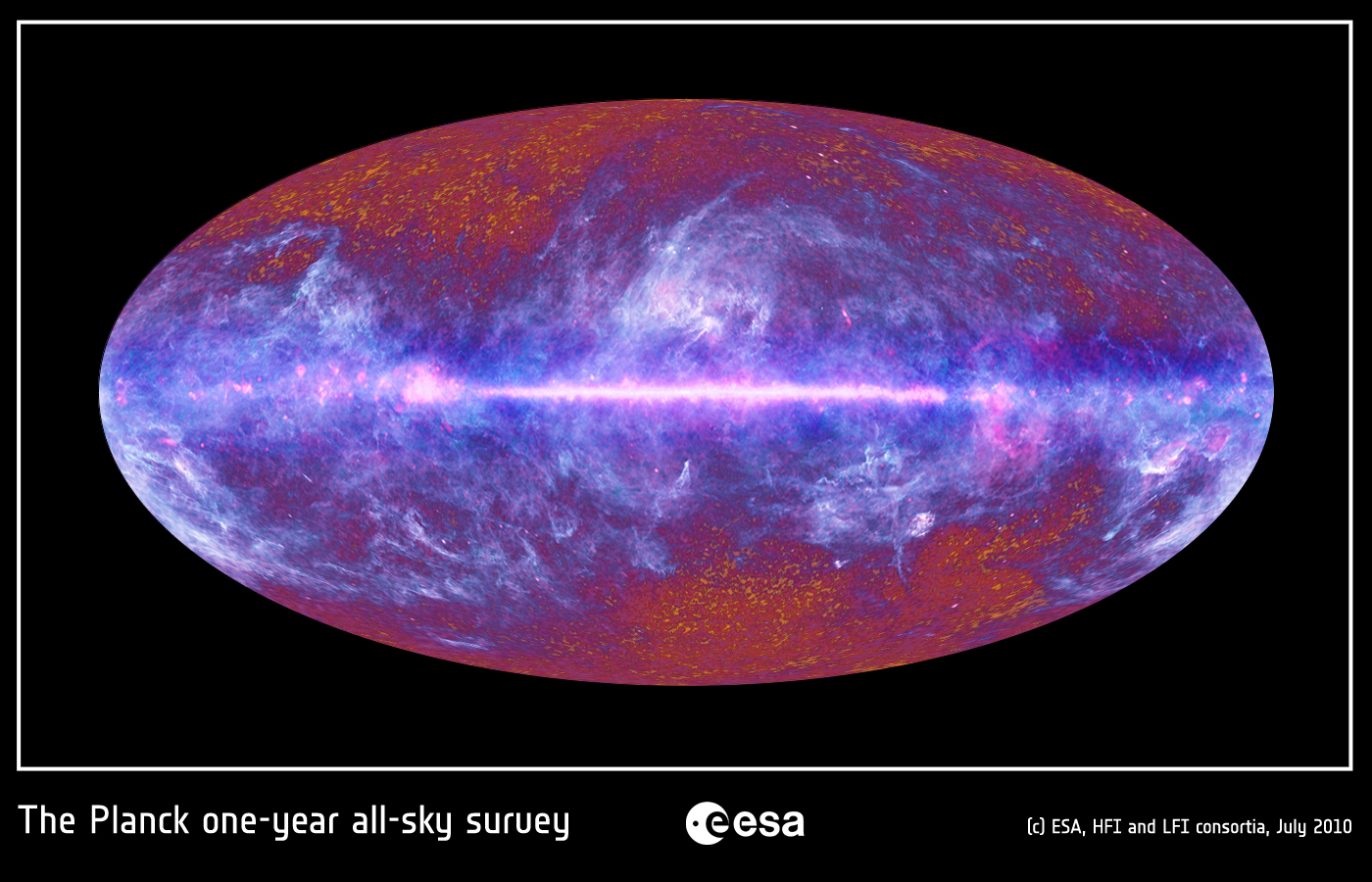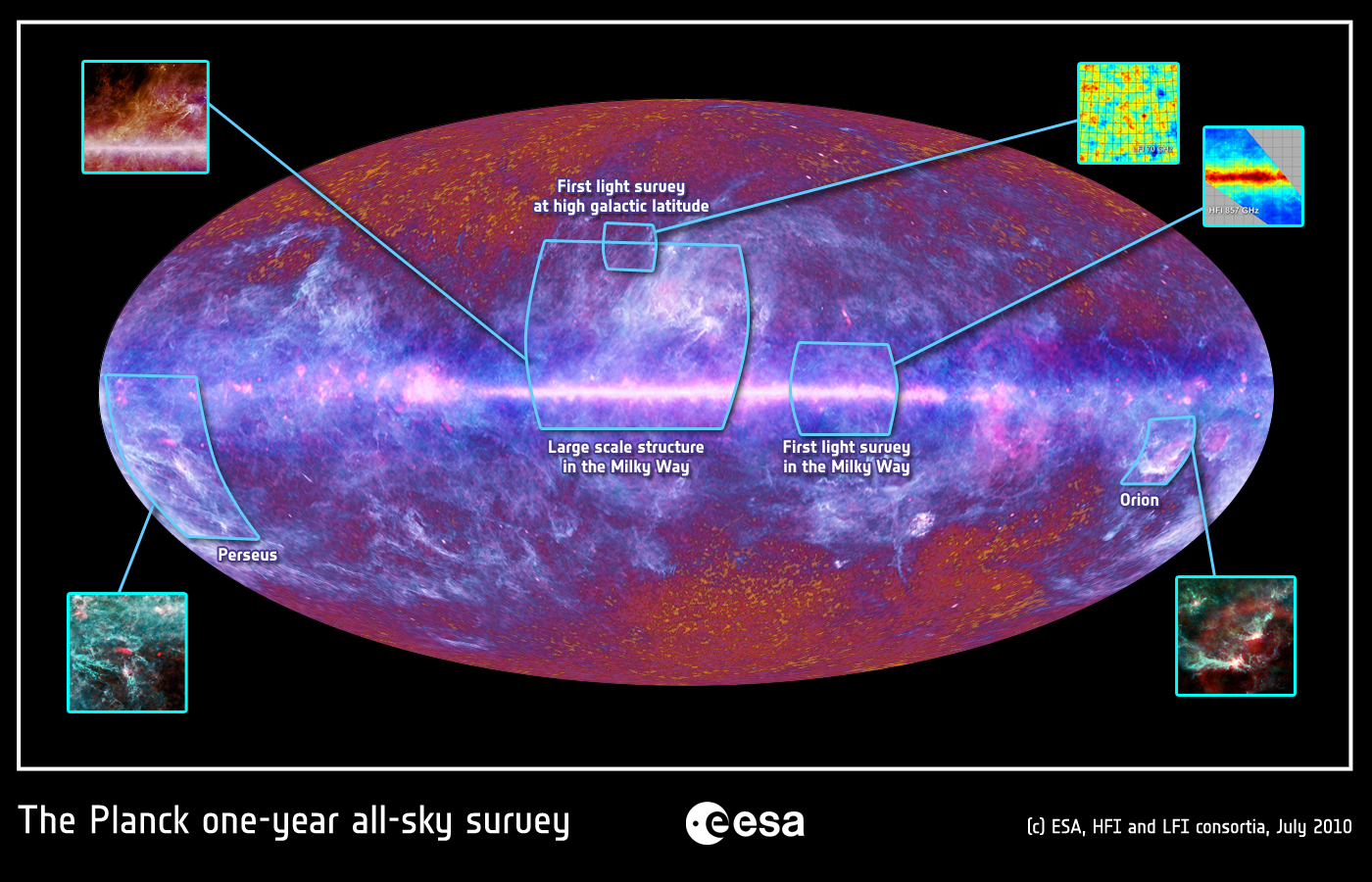Planck unveils the Universe - old and young
5 July 2010

A false-colour image of the whole sky as seen by Planck. The dust throughout the Galaxy is shown in blue, while hot gas can be seen as red regions across the centre of the image. In the background, the mottled yellow features are relic radiation, called the Cosmic Microwave Background, which contains information about the earliest stages of the Universe. This image is a low-resolution version of the full data set.
Image Credits: ESA, LFI and HFI Consortia (2010)
The Planck satellite—ESA's mission to study the early Universe—has delivered its first image of the entire sky. By looking at microwave radiation, it not only provides new insight into the way stars and galaxies form, but also tells us how the Universe itself came to life after the Big Bang.
From the closest portions of the Milky Way to the furthest reaches of space and time, the new all-sky Planck image is an extraordinary treasure chest of new data for astronomers.
Professor George Efstathiou, Planck Survey Scientist at the University of Cambridge, said
"it has taken sixteen years of hard work by many scientists in Europe, the USA and Canada, to produce this new image of the early Universe. Planck is working brilliantly and we expect to learn a lot about the Big Bang and the creation of our Universe."
The main disc of our Galaxy runs across the centre of the image. Immediately striking are the streamers of cold dust reaching above and below the Milky Way. This Galactic web is where new stars are being formed, and Planck has found many locations where individual stars are edging toward birth or just beginning their cycle of development.
Professor Richard Davis, part of the team that constructed components of Planck at the University of Manchester, said that
"This image shows that our Galaxy is full of gas and dust at a whole range of temperatures, some from old stars and some forming new stars. It also shows the sort of material that formed us - and it is beautiful."
Less spectacular but perhaps more intriguing is the mottled backdrop at the top and bottom. This is the cosmic microwave background (CMB) radiation. It is the oldest light in the Universe, the remains of the fireball out of which our Universe sprang into existence 13.7 billion years ago.
While the Milky Way shows us what our local neighbourhood looks like now, those microwaves show us what the Universe looked like close to its time of creation, before there were stars or galaxies. The CMB radiation was released as the first atoms were forming, about 400 000 years after the Big Bang, and is at the heart of Planck's mission to decode what happened in the primordial Universe.
The microwave pattern is the cosmic blueprint from which today's clusters of galaxies were built. The different colours represent minute differences in the temperature and density of matter across the sky. Through the action of gravity, these small irregularities evolved into denser regions that became the galaxies of today.
The CMB covers the entire sky but most of it is hidden in this image by the Milky Way's emission, which must be digitally removed from the final data in order to see the microwave background in its entirety. Planck looks at the sky in nine different bands, or colours, of microwave light, which have wavelengths thousands of times that of optical light. These nine different bands, ranging from frequencies of 30 to 850 GHz, are crucial for understanding which parts of the Planck data are from the early Universe, and which are from our own Galaxy.

The all-sky map with overlays showing the regions where images from Planck have previously been released.
Image Credits: ESA, LFI and HFI Consortia
Dr Clive Dickinson, who works on the Galactic emission that Planck sees at the University of Manchester, commented that
"Planck lets us see our Galaxy in a completely new way. The different colours in the image show different components of the interstellar medium (the material between the stars in our Galaxy) including different types of gas and dust. Planck has the unique ability to separate different types of dust at temperatures of just a few to tens of degrees above absolute zero - highlighting regions of space that are likely to be where stars form. Planck maps will allow us to study such regions over large regions of sky for the first time."
A number of UK institutions have been involved in the design and construction of the satellite, and are now working alongside colleagues from around the world to operate the satellite and analyse the data.
When this work is completed, Planck will show us the most precise picture of the cosmic microwave background ever obtained. The big question will be whether the data will reveal the cosmic signature of the primordial period called inflation. This era is postulated to have taken place just after the Big Bang and resulted in the Universe expanding enormously in size over an extremely short period. It is a cornerstone of the standard cosmological model, and results from sensitive experiments such as Planck are required to increase our understanding of it.
Dr Bob Watson, also of the University of Manchester, said
"The wealth of rich structure in this image really brings home to me incredible breadth of scale that the Planck maps cover. From the cosmic scale of the CMB which has information on the early history, shape and dynamics of the whole Universe to the delicate web of gas, dust and high energy electrons within our own galaxy. In both areas, far and near, Planck will undoubtedly lead to a greater understanding the Universe and how our galaxy works within."
The image shown here is constructed from data taken from the first ten months of Planck's main mission, with observations beginning in August 2009. Planck continues to map the Universe, and by the end of its mission in 2012 it will have imaged the whole sky four times. The first full data release of the CMB is planned for 2012. Before then, a catalogue containing individual objects, both regions in our Galaxy and entire distant galaxies, will be released in January 2011.
Emeritus Professor Rod Davies from the University of Manchester, who is leading the work to understand the Galactic emission seen by Planck, said
"it is particularly rewarding for me to see the culmination of a 30-year involvement in Cosmic Microwave Background research beginning with radio telescopes at Jodrell Bank in Cheshire, then under the clear dry skies on the high volcanic slopes of Tenerife and finally with the construction by Jodrell Bank of the radio receivers for Planck's Low Frequency Instrument."For more information, please see:
The map is also available on Chromoscope, where it can be compared with images at other wavelength.
Editors notes:
Planck maps the sky in nine frequencies using two state-of-the-art instruments, designed to produce high-sensitivity, multi-frequency measurements of the diffuse sky radiation: the High Frequency Instrument (HFI) includes the frequency bands 100-857 GHz (wavelengths of 3mm to 0.35mm), and the Low Frequency Instrument (LFI) includes the frequency bands 30-70 GHz (wavelengths of 10mm to 4mm).
The first Planck all-sky survey began in August 2009 and was completed in late-May 2010. Planck will gather data until the end of 2012, during which time it will complete four sky scans. A first batch of astronomy data, called the Early Release Compact Source Catalogue, is scheduled for release in January 2011. To arrive at the main cosmology results will require about two years of data processing and analysis. The first set of processed data will be made available to the worldwide scientific community towards the end of 2012.
UK role in Planck
A number of UK institutes and companies form part of the consortium building the two focal plane instruments, the HFI (High Frequency Instrument) and LFI (Low Frequency Instrument). The Jodrell Bank Observatory at The University of Manchester has produced critical elements of the LFI receiver modules. Cardiff University, STFC RAL and SEA have been involved with hardware development for HFI, while various UK research groups including Imperial College London and University of Cambridge form the London Planck Analysis Centre and Cambridge Planck Analysis Centre. These groups are involved with data analysis and simulation for the HFI data analysis and simulation software. More information can be found in the Planck briefing document.
Jodrell Bank's role in Planck
Jodrell Bank Centre for Astrophysics (JBCA) is directly involved with the two lowest frequencies of the Low Frequency Instrument, the 30 and 44 GHz radiometers. These have 4 and 6 detectors respectively, operating at 20K (-253.15°C or -423.67°F). The resolution on the sky will be 33 and 27 arc minutes, and the sensitivity 1.6 and 2.4 micro K (1s, over 12 months). The cryogenic low noise amplifiers which are the heart of the radiometers were developed at Jodrell Bank, with help from the University of Birmingham and The Rutherford Appleton Laboratory.
Dr B. Maffei and Dr G. Pisano are involved in the other focal instrument, the HFI. First at Cardiff University and now at the University of Manchester, they have played a major role in the design, development and calibration of the Focal Plane Unit, in particular the cold optics, in collaboration with the Institut d'Astrophysique Spatiale - France, Maynooth University - Ireland and JPL/Caltech - USA.
The work to understand the Galactic emission seen by Planck is being co-lead from Jodrell Bank by Emeritus Professor Rod Davies. A number of projects are led by Jodrell Bank scientists, including Professor Richard Davis and Dr Clive Dickinson. Each of the 14 projects focusses on one aspect of the Galaxy as seen by Planck, including the electrons that gyrate in the Galactic magnetic field, the ionized gas that pervades the interstellar medium and the dust grains that emit across the entire frequency range that Planck is sensitive to. Jodrell Bank is also leading the calibration and identifying systematics in the LFI data.
Contacts
For more information please contact
Professor Richard Davis,
Jodrell Bank Centre for Astrophysics,
Alan Turing Building,
The University of Manchester,
Oxford Road,
Manchester M13 9PL
rjd[@]jb.man.ac.uk
+44 (0)161 275 4164.
Dr Chris North,
School of Physics and Astronomy,
Cardiff University,
Queen's Buildings,
The Parade,
Cardiff CF42 3AA
chris.north[@]astro.cf.ac.uk
+44 (0)129 208 70537
Jan Tauber, Planck Project Scientist
Science and Robotic Exploration Directorate
European Space Agency, The Netherlands
jtauber[@]rssd.esa.int
+31 71 565 5342.


